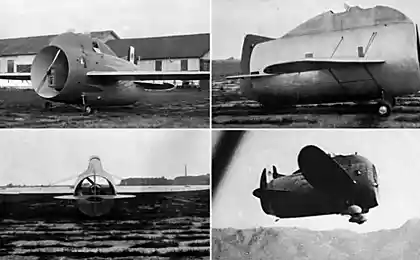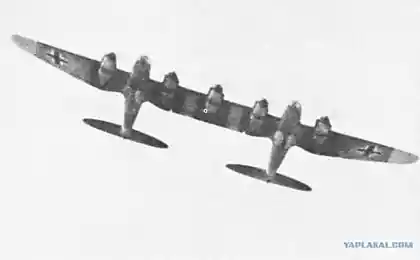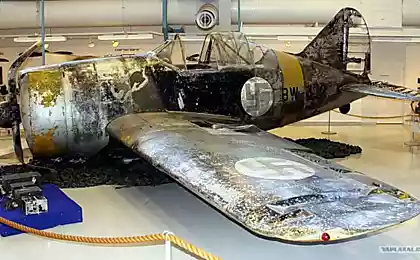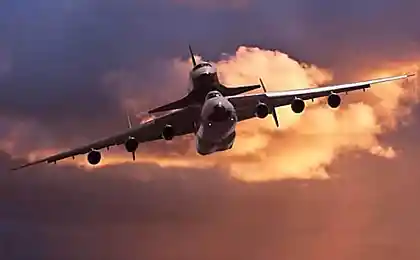1303
Reverse

During the run on the strip after touching an airplane mass of the order of 70-80 m it is necessary to slow down the rate of more than two hundred kilometers per hour to about 40-60. This should be done rapidly, as the band is not infinite, and has a length of about two or three kilometers.
That's how things are going:
when the plane just touches the strip, wing still creates a greater lifting force (here it is bent upwards).

Almost immediately reverses.

Shifted folds very quickly and in a split second are fully open.

But this is, strictly speaking, not the reverse :)
The fact that the Tu-154 has two control handles reverse position (PVP): a small reverse and full reverse.
Small reversed - is only relaying the flaps without increasing the engine speed (rpm). In this case, simply extinguished whole thrust of the engine.
Full reverse - is to increase the engine speed (RPM) with open flaps. There is already the engine and creates a reverse thrust.
The reverse is valuable because it can slow the plane when the brakes may not work.
Do not work because they are at high speed immediately after touching the load on the wheels is too small - most of the weight of the aircraft is compensated lifting force of the wing.
Extinguished by this lift spoilers - flaps on the upper surface of the wing.
Just visible on the photo to begin issuing spoilers (tёmnenkoe on the wing in the area of the rear window 4-5 emergency exit on the wing).
But they are more clearly behind:

Spoilers are released automatically when the airplane in the landing configuration and landing gear crimped.
Released spoilers quenched lifting force of the wing, the aircraft settles and stronger wheels pressed against the surface. You can now apply the brakes. Brakes and quenched most of the speed and energy of the aircraft.
Our aircraft also has a system of automatic priuborki flap to even further reduce the lift force.
According to the Aircraft flight manual, the reverse should be turned off at a speed of 100 km / h, so as not to suck a band that has got; use only on the brakes. In practice, it is turned off with a margin of a few tens of km / h, for the store is no sore and reprimands in this case does not involve (and for blown by the speed off may chide).

The peculiarity of this engine (D-30KU) that is used to reverse its own, separate hydraulic system with its tank, accumulators and other personal belongings (everything is on the nozzle).
Accordingly:
filter changes, and on the reverse,
liquid fill in reverse (and it is - it is necessary to climb on top of the pylon and very uncomfortable - a small hatch, but also a need to Lock the cover :)).
And most importantly - each Destination Tu-154 must be at the extreme pressure accumulators engines poison reverse.
Because if you do not bleed, then when polezesh look turbine and some in the cockpit dёrnet handle, one technician will be less.
And it becomes.
So - ladder in the teeth, and poison the pressure valve in the hatch 1 and 3 engines (2nd no reversion).
Very convenient, yes. Of course, for the 30 years of operation, it was impossible to think of finalizing any valve, bleed the pressure after the engine stops. This - very simple task for a great aviation power.
And then not only grumbling about convenience (although this all the time).
It is said that there were several instances when the pressure bleed forgotten (or once was), and then the engine was removed and brought the crowd to the cart, pushing it. Someone touched his hand reverser lever, and another uncle Vasya becomes smaller. Sash shifted in a split second.
Several people killed this design. Speak.

Small comment to the very first photo.
Reverse 154 is only on external engines. Therefore, the second engine in this process is not only useful, but even harmful - it creates the forward thrust.
This engine is sometimes turned off at the taxi, since traction on a small gas from these engines (D-30KU-154) is quite large, and often have to slow down the plane (which leads to the heat and wear on the brakes).
And most importantly:
Engine rotors always rotate in the same direction at all operating conditions.
Just the direction of the jet stream at the output of the engine is changed by a variety of devices (grilles, dampers, buckets and so on. D.).
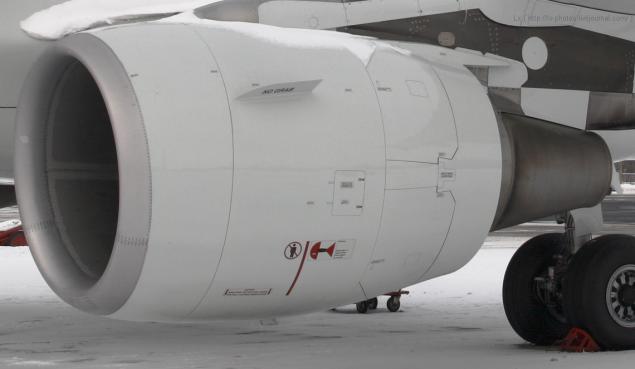
_____________________________________________________________________________________
REVERSE on foreign cars:


By default, we will talk about the engine CFM-56-5. This is from the Airbus 320 family.
If about others, it will be referred to specifically.

So ...
When the engine is good and direct flow, then it looks, respectively.
Something like this:

Everything is wonderful, yet flies.
But here on the strip there is such a need for the pilot to slow down his chair.
Basic to this - the brake wheel.
But to save the add (and kraynyak) is in the engine reverse.
A device for directing a portion of the jet forward in flight and thus creating reverse thrust.
It is used mainly on the run after landing.
The effectiveness of the reverse - so yourself. According to rumors, made from 100% inhibition of about 70% are on the brakes, and only about 30% - on the reverse (number srednepotolochnye so rotten tomatoes reserved for another time).
Here is the place
relaxed:

Arrangement and reverse:

Reversing the flow is achieved by overlapping of the buckets or flaps.
Then the air has nowhere to go and it flies wherever he was sent, forward at an angle to the axis of the engine.
On the backside:

Each ear is given its cylinder:

As you can see, running part of the outer contour almost completely blocked:

But it is important not only reverse.
Reverse flow hoods form part of the outer contour of the engine (where the air blowing fan after), that is the very high-torque loop.
These hoods can be opened to access the hot parts of the engine.
First, open the hood fan, then Reverse:

Behind all open hoods look like:
Hot part:
(By the way, the output of the fan vanes - plastic :))
And finally, again on the reversal.
On different engines exciting looks:
A32x
But on the 737 also overlaps only the outer contour. In this case, the leaf reverse shift back and forward air is directed lattices:
On the CFM-56 is used to drive the hydraulic fluid from the hydraulic Jets.
There reversers with an air driven (engine NK-8-2 on the Tu-154 and motor 767 th CF6-80 too). I seem to be such less reliable.
Approximately so.
p.s.
Screw planes reversion turning the propeller blades with a constant direction of rotation thereof.
On the grounds lx-photos.livejournal.com
My favorite "mymra" of the country. Alice Freundlich 80 years
Famous beauties who have never been married
